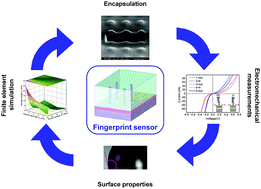当前位置:
X-MOL 学术
›
J. Mater. Chem. C
›
论文详情
Our official English website, www.x-mol.net, welcomes your
feedback! (Note: you will need to create a separate account there.)
Design of UV-crosslinked polymeric thin layers for encapsulation of piezoelectric ZnO nanowires for pressure-based fingerprint sensors†
Journal of Materials Chemistry C ( IF 5.7 ) Pub Date : 2017-12-14 00:00:00 , DOI: 10.1039/c7tc04153e A. Bouvet-Marchand 1, 2, 3, 4, 5 , A. Graillot 1, 2, 3 , J. Volk 6, 7, 8 , R. Dauksevicius 9, 10, 11, 12 , C. Sturm 13, 14, 15 , M. Grundmann 13, 14, 15 , E. Saoutieff 16, 17, 18, 19, 20 , A. Viana 16, 17, 18, 19, 20 , B. Christian 15, 21, 22 , V. Lebedev 15, 21, 22 , J. Radó 6, 7, 8, 23, 24 , I. E. Lukács 6, 7, 8, 23, 24 , Q. Khánh N. 6, 7, 8 , D. Grosso 3, 4, 5, 25 , C. Loubat 1, 2, 3
Journal of Materials Chemistry C ( IF 5.7 ) Pub Date : 2017-12-14 00:00:00 , DOI: 10.1039/c7tc04153e A. Bouvet-Marchand 1, 2, 3, 4, 5 , A. Graillot 1, 2, 3 , J. Volk 6, 7, 8 , R. Dauksevicius 9, 10, 11, 12 , C. Sturm 13, 14, 15 , M. Grundmann 13, 14, 15 , E. Saoutieff 16, 17, 18, 19, 20 , A. Viana 16, 17, 18, 19, 20 , B. Christian 15, 21, 22 , V. Lebedev 15, 21, 22 , J. Radó 6, 7, 8, 23, 24 , I. E. Lukács 6, 7, 8, 23, 24 , Q. Khánh N. 6, 7, 8 , D. Grosso 3, 4, 5, 25 , C. Loubat 1, 2, 3
Affiliation

|
The demand for biometric identification, and more particularly fingerprint recognition, has significantly increased in recent years in domains such as national security, controlled access to health care, banking and leisure. Typical resolution of current fingerprint sensors constitutes 500 dpi, which conforms to the FBI standard for the detection of level 1 (pattern) and level 2 (minutiae) features. However, at least 1000 dpi is required to extract the tiniest level 3 features such as shape of pores and ridge edges. To address an increasing need for the highest reliability in fingerprint identification, this work presents the elaboration of a specific encapsulation polymeric layer for a new design of a pressure sensor which is expected to provide higher resolution and minimal volume occupation compared to already existing setups. The sensor comprises a periodic array of individually contacted piezoelectric ZnO nanowires (NWs), which generate piezopotentials when deformed (each electrically addressable NW constitutes a pressure-sensitive pixel). Fragile NWs cannot undergo direct contact with the finger, therefore a polymeric encapsulation layer is required to simultaneously provide physical protection and to transfer the force from the finger to the NWs. To ensure sensor robustness, the polymeric layer must also exhibit appropriate chemical inertness, and water- and oil-repellency. To achieve this aim, novel formulations of UV-crosslinkable polymeric materials were developed, prepared and deposited as thin layers on the NWs using spin-coating by following the recommendations derived from numerical simulations. An ideal balance between polymer formulation processability and final thin layer's characteristics (Young's modulus, thickness) was identified. The resulting encapsulation layer was proved to properly protect the piezoelectric ZnO nanowires from breaking under pressure forces and from being contaminated with external impurities while enabling successful collection of electrical signals in a bottom–bottom contacted NW configuration.
中文翻译:

紫外线交联的聚合物薄层的设计,用于封装基于压力的指纹传感器的压电ZnO纳米线†
近年来,在诸如国家安全,可控制的医疗保健,银行和休闲等领域,对生物识别尤其是指纹识别的需求已大大增加。当前指纹传感器的典型分辨率为500 dpi,符合用于检测1级(图案)和2级(细节)特征的FBI标准。但是,至少需要1000 dpi才能提取出最细微的3级特征,例如孔的形状和山脊边缘。为了满足对指纹识别中最高可靠性的不断增长的需求,这项工作提出了一种用于新型压力传感器设计的特殊封装聚合物层,与现有技术相比,该传感器有望提供更高的分辨率和最小的体积占用。该传感器包括单独接触的压电ZnO纳米线(NW)的周期性阵列,它们在变形时会产生压电势(每条可电寻址的NW构成一个压敏像素)。易碎的NW无法与手指直接接触,因此需要聚合物封装层同时提供物理保护并将力从手指传递到NW。为了确保传感器的坚固性,聚合物层还必须表现出适当的化学惰性以及拒水拒油性。为了达到这个目的,按照数值模拟的建议,使用旋涂技术开发,制备了可紫外线交联的高分子材料新配方,并以薄层形式沉积在西北部。确定了聚合物配方可加工性与最终薄层特性(杨氏模量,厚度)之间的理想平衡。事实证明,所形成的封装层可以适当地保护压电ZnO纳米线,使其免于在压力作用下断裂,并免受外部杂质的污染,同时能够以底部-底部接触的NW配置成功收集电信号。
更新日期:2017-12-14
中文翻译:

紫外线交联的聚合物薄层的设计,用于封装基于压力的指纹传感器的压电ZnO纳米线†
近年来,在诸如国家安全,可控制的医疗保健,银行和休闲等领域,对生物识别尤其是指纹识别的需求已大大增加。当前指纹传感器的典型分辨率为500 dpi,符合用于检测1级(图案)和2级(细节)特征的FBI标准。但是,至少需要1000 dpi才能提取出最细微的3级特征,例如孔的形状和山脊边缘。为了满足对指纹识别中最高可靠性的不断增长的需求,这项工作提出了一种用于新型压力传感器设计的特殊封装聚合物层,与现有技术相比,该传感器有望提供更高的分辨率和最小的体积占用。该传感器包括单独接触的压电ZnO纳米线(NW)的周期性阵列,它们在变形时会产生压电势(每条可电寻址的NW构成一个压敏像素)。易碎的NW无法与手指直接接触,因此需要聚合物封装层同时提供物理保护并将力从手指传递到NW。为了确保传感器的坚固性,聚合物层还必须表现出适当的化学惰性以及拒水拒油性。为了达到这个目的,按照数值模拟的建议,使用旋涂技术开发,制备了可紫外线交联的高分子材料新配方,并以薄层形式沉积在西北部。确定了聚合物配方可加工性与最终薄层特性(杨氏模量,厚度)之间的理想平衡。事实证明,所形成的封装层可以适当地保护压电ZnO纳米线,使其免于在压力作用下断裂,并免受外部杂质的污染,同时能够以底部-底部接触的NW配置成功收集电信号。











































 京公网安备 11010802027423号
京公网安备 11010802027423号